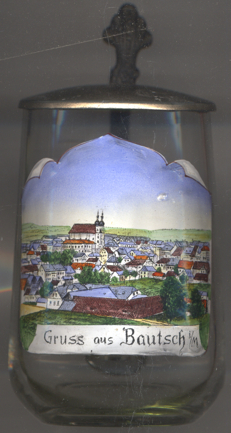

|
| ČESKÁ REPUBLIKA | CZECH REPUBLIC |
| Moravskoslezský kraj | North Moravia and Silesia (Ostrava) region |
| Okres: Opava |
Budišov nad Budišovkou is situated at an elevation of 512 m in the Moravian-Silesian Region of the Czech Republic, about 30 km southwest of the district town, Opava. The municipality of Budišov nad Budišovkou has a population of about 2,900 (2016).
 The village was first mentioned in a written document in 1239 in relation to a dispute between the monastery of
Hradisko and the cathedral chapter of Olomouc. A document of 1301 suggests that Budišov
already at that time had the character of a town. At that time it was the centre of the local silver mining activities.
In 1323 it became a property of the archbishops of Olomouc. Budišov flourished in the 15th, 16th century. However,
during the Thirty Years' War (1618–1648) it was destroyed by Swedish and Danish troops. Ensuing epidemics further
decimated the population. As the town was located far from the major traffic routes, the industrialisation of the 19th
century did not affect Budišov. Home weaving and some clay shale mining remained the major trades until a tobacco
factory was founded in 1870. The branch line from Bautsch to Zauchtel (Suchdol nad Odrou) connected the
town to the railroad system in 1891 so that finally more factories were founded. After World War I the area
became part of Czechoslovakia with the Treaty of Saint-Germain-en-Laye (1919). Still, 95% of the population were
German-speaking. The Munich Agreement (1938) between the main powers of Europe (excluding the
Soviet Union) permitted the annexation of the area to Germany as part of the district Bärn
(Moravský Beroun). Most of the Czech-speaking remaining population were expelled until later
of that year. After World War II the area was returned to the Czech Republic. On the basis of the Beneš decrees,
the German-speaking population was expelled and dispossessed, and Bautsch was renamed Budišov nad Budišovkou.
The village was first mentioned in a written document in 1239 in relation to a dispute between the monastery of
Hradisko and the cathedral chapter of Olomouc. A document of 1301 suggests that Budišov
already at that time had the character of a town. At that time it was the centre of the local silver mining activities.
In 1323 it became a property of the archbishops of Olomouc. Budišov flourished in the 15th, 16th century. However,
during the Thirty Years' War (1618–1648) it was destroyed by Swedish and Danish troops. Ensuing epidemics further
decimated the population. As the town was located far from the major traffic routes, the industrialisation of the 19th
century did not affect Budišov. Home weaving and some clay shale mining remained the major trades until a tobacco
factory was founded in 1870. The branch line from Bautsch to Zauchtel (Suchdol nad Odrou) connected the
town to the railroad system in 1891 so that finally more factories were founded. After World War I the area
became part of Czechoslovakia with the Treaty of Saint-Germain-en-Laye (1919). Still, 95% of the population were
German-speaking. The Munich Agreement (1938) between the main powers of Europe (excluding the
Soviet Union) permitted the annexation of the area to Germany as part of the district Bärn
(Moravský Beroun). Most of the Czech-speaking remaining population were expelled until later
of that year. After World War II the area was returned to the Czech Republic. On the basis of the Beneš decrees,
the German-speaking population was expelled and dispossessed, and Bautsch was renamed Budišov nad Budišovkou.
The  parish church of the Ascension of Our Lady [background centre]
was built in 1746–1755 in Baroque style by the architect Nikolaus Thalherr.
parish church of the Ascension of Our Lady [background centre]
was built in 1746–1755 in Baroque style by the architect Nikolaus Thalherr.
[https://de.wikipedia.org/wiki/Budišov_nad_Budišovkou,https://en.wikipedia.org/wiki/Budišov_nad_Budišovkou]
![[scale]](lineal.jpg)